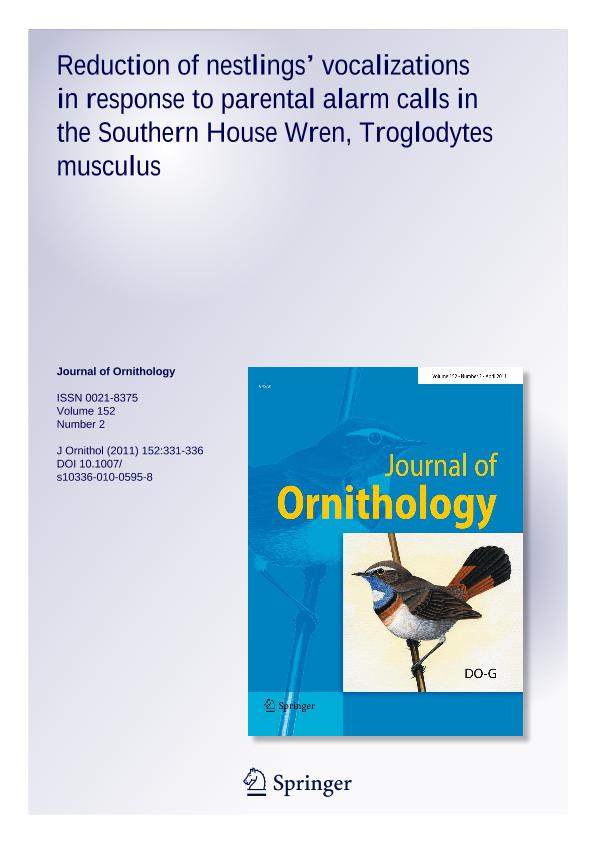Mostrar el registro sencillo del ítem
dc.contributor.author
Serra, Catalina

dc.contributor.author
Fernandez, Gustavo Javier

dc.date.available
2019-01-28T18:11:26Z
dc.date.issued
2011-04
dc.identifier.citation
Serra, Catalina; Fernandez, Gustavo Javier; Reduction of nestlings' vocalizations in response to parental alarm calls in the Southern House Wren, Troglodytes musculus; Wiley Blackwell Publishing, Inc; Journal Fur Ornithologie; 152; 2; 4-2011; 331-336
dc.identifier.issn
0021-8375
dc.identifier.uri
http://hdl.handle.net/11336/68761
dc.description.abstract
Breeding birds often give alarm calls when a predator is near the nest. These calls have been proposed to serve as distraction displays for the predator, alerts for a mate conveying information about the presence of a threat, or a warning for nestlings about a potential risk. These functions, however, may not be mutually exclusive. In our study, we assessed if alarm calls uttered by breeding Southern House Wrens, Troglodytes musculus, are made to warn nestlings about risk. If so, we expected that nestlings would reduce overall activity in the nest and that the parents' call rate would be related to the detectability of the young (e. g., vocalizations). We experimentally elicited parents' alarm calls and compared nestling behavior before and after giving that stimulus. We found that Southern House Wren nestlings reduced their time spent vocalizing and remained inactive for longer when their parents called. Therefore, nestlings reduced their detectability by decreasing their activity inside the nest when their parents produced alarm calls. On the other hand, parental calling rates were not related to the nestling activity registered in any experimental stage. Therefore, we failed to find reliable results supporting the hypothesis that parent calling is uttered to silence nestlings. These results appear to indicate that alarm calling by breeding birds might fulfill other functions besides alerting nestlings. Future studies of this species are necessary to understand if parents are warning nestlings about a threat when they emit alarm calls.
dc.format
application/pdf
dc.language.iso
eng
dc.publisher
Wiley Blackwell Publishing, Inc

dc.rights
info:eu-repo/semantics/openAccess
dc.rights.uri
https://creativecommons.org/licenses/by-nc-sa/2.5/ar/
dc.subject
Alarm Calls
dc.subject
Begging
dc.subject
Communication
dc.subject
Predation Risk
dc.subject.classification
Otras Ciencias Biológicas

dc.subject.classification
Ciencias Biológicas

dc.subject.classification
CIENCIAS NATURALES Y EXACTAS

dc.title
Reduction of nestlings' vocalizations in response to parental alarm calls in the Southern House Wren, Troglodytes musculus
dc.type
info:eu-repo/semantics/article
dc.type
info:ar-repo/semantics/artículo
dc.type
info:eu-repo/semantics/publishedVersion
dc.date.updated
2019-01-25T13:34:51Z
dc.journal.volume
152
dc.journal.number
2
dc.journal.pagination
331-336
dc.journal.pais
Reino Unido

dc.journal.ciudad
Londres
dc.description.fil
Fil: Serra, Catalina. Universidad de Buenos Aires. Facultad de Ciencias Exactas y Naturales. Departamento de Ecología, Genética y Evolución; Argentina
dc.description.fil
Fil: Fernandez, Gustavo Javier. Universidad de Buenos Aires. Facultad de Ciencias Exactas y Naturales. Departamento de Ecología, Genética y Evolución; Argentina. Consejo Nacional de Investigaciones Científicas y Técnicas. Oficina de Coordinación Administrativa Ciudad Universitaria. Instituto de Ecología, Genética y Evolución de Buenos Aires. Universidad de Buenos Aires. Facultad de Ciencias Exactas y Naturales. Instituto de Ecología, Genética y Evolución de Buenos Aires; Argentina
dc.journal.title
Journal Fur Ornithologie

dc.relation.alternativeid
info:eu-repo/semantics/altIdentifier/url/https://link.springer.com/article/10.1007/s10336-010-0595-8
dc.relation.alternativeid
info:eu-repo/semantics/altIdentifier/doi/https://doi.org/10.1007/s10336-010-0595-8
Archivos asociados
